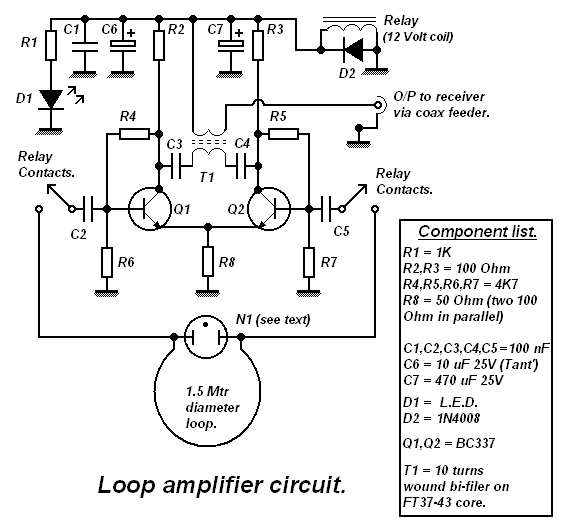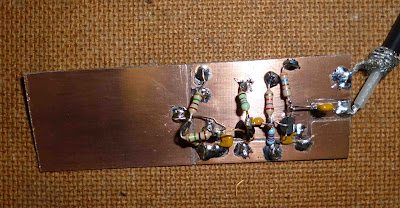Variously described as orienteering with radios or hide and seek for grown-ups (or not very grown-up in most cases).
The general idea is that someone will hide themselves away in the area covered by a particular 1:50k OS map, around 1600sq km. They’ll have a radio transmitter with which they’ll transmit for short periods. Some transmissions are scheduled whilst others are random.
The only rules the transmit station has to adhere to, apart from the Amateur Radio Licence regulations, are that they must be located in an area of public access, not be in a building, and once established they must not change position. It’s a given that the transmitter doesn’t change frequency during the event. The fun begins when the competitors have to locate the hidden station – first one in is the winner. Obviously.
The transmitting station operates on Top Band, or 160m. The actual frequency coverage of the band is from 1.81mhz to 2mhz, just below the Medium Wave broadcast band. Because it’s fairly low in frequency (= long wavelength) the aerial needs to be quite long, ideally a quarter-wavelength wire - around 40m long.
The competitors are equipped with map and compass, and most importantly a radio receiver fitted with a highly directional aerial. The radios are home-made, commercial equipment generally isn’t sufficiently portable or affordable.
 Top Right: Transmitter, Centre: DF Receiver, Bottom Left: Breton Plotter
Top Right: Transmitter, Centre: DF Receiver, Bottom Left: Breton Plotter
So, on Sunday morning a group of DFers gathered in Sale, Cheshire, and strained their ears (and other bits too probably) to get a bearing on the hidden transmitter’s first transmission, scheduled for 10am.
 At the start
At the start
Unfortunately the signal was completely inaudible. In such cases there’s a sealed envelope available at the start which contains an approximate bearing (+/- 20 degrees) and an idea of distance, usually within 10km. This can still be a huge area to search.
Not being able to hear the transmitter at the start can be a clue – it’s possible that the station is hidden in a valley so that the signal isn’t being radiated too well. It could also be that the operator decided not to bother and stayed in bed instead….or perhaps he/she fell in a river, fetid swamp, or got eaten by an alligator recently escaped from a zoo. Or more likely a private collection.
Anyroadup, the approximate bearing given was 67degrees which passed within 4km of the transmitter, and the distance given was between 10 and 20km from the start. A quick faff with maps, rulers and pencils soon had the hunting area defined on the map, and competitors jumped into their cars to find somewhere suitable to take a bearing from the second transmission.
In theory two bearings are needed to locate the transmitter…..where the lines cross is where the station SHOULD be. That’s if the laws of physics are to be believed. After all, electromagnetic radio waves travel in straight lines – everybody knows that. Except they don’t.
All manner of external influences can distort radiation patterns, the proximity to pylons and overhead power cables being prime examples.
I’m not particularly mithered about winning, it’s always nice to do well of course, but I just like to enjoy the event. I left the start and travelled around the M60 towards Ashton-under-Lyne at a sedate 60-65mph. I’d pin-pointed a couple of spots where I’d try to take a second bearing and headed straight for the first one, arriving in good time for the second scheduled transmission….nothing heard.
At the third transmission I heard a good loud signal. I plotted the bearing, then jumped back into the car and drove half a mile up the road where I just managed to get another bearing before the station went off air.
Suspicions grew as to where the station might be…..very close to where Gayle and I had walked a few days earlier, Daisy Nook Country Park. I plotted the bearing onto my map and drove close to the point where the lines crossed – arriving just in time to hear another brief transmission.
My suspicions were confirmed, the signal was so strong that it overloaded my radio. I was obviously very close indeed.
I left the car and followed muddy footpaths towards the River Medlock. After much slipping and sliding, charging across the river (I was wearing my fell-running shoes!) and thrashing through very wet undergrowth I spotted the very well camouflaged station.
 Roger, the station operator, now not hiding himself away. The box closest to him is the transmitter. The white-ish square(ish) piece of kit is my DF receiver.
Roger, the station operator, now not hiding himself away. The box closest to him is the transmitter. The white-ish square(ish) piece of kit is my DF receiver.
At approximately 11.27am (exactly!) I officially found the transmitter. Surprise, surprise – I was first in.
 Posing with Roger, a slightly (very) muddied JJ….looking quite pleased with his little self
Posing with Roger, a slightly (very) muddied JJ….looking quite pleased with his little self
Around 10 minutes later we were alerted to the sound of someone crashing through the undergrowth on the other side of the river, looking for the hidden station. We kept perfectly still, trying hard not to snigger, as we watched with no small amount of glee as Chris splashed his way through the mud and bog. When he actually spotted us he declared he wasn’t going to cross the river, he hadn’t won so why bother?!

Chris, who didn’t come first, was heard to say something like ‘bugger crossing that river’
The next half hour or so saw the remaining competitors finding the transmitter – all coming in from a similar direction….and the wrong side of the river.

Chris and Roger, daring each other to cross the river

A happy Geoff, officially second in – because he crossed the river
 Determined not to be outdone, Hayley crosses the river
Determined not to be outdone, Hayley crosses the river
 An excellent lunch at The Hare & Hounds, Luzley
An excellent lunch at The Hare & Hounds, Luzley
Results:
JJ 11:27
Chris P 11:40 (Located the station but didn’t cross the river)
Geoff Foster 11:42
Roger B 11:48 (Located the station but didn’t cross the river)
Hayley 11:57
Dave Chipp 11:57:30 (Located the station but didn’t cross the river)

Plotted route shows my route in, a bit all over the place as I was trying to take multiple compass bearings on the hidden station in order to triangulate it’s position

The arrow points to the hidden station, the red line is the approx bearing from the start. The station was 10 miles from the start, as the crow flies.
Being as wot I came in first it’s down to me to hide on the next event, scheduled for 11th January.


















































